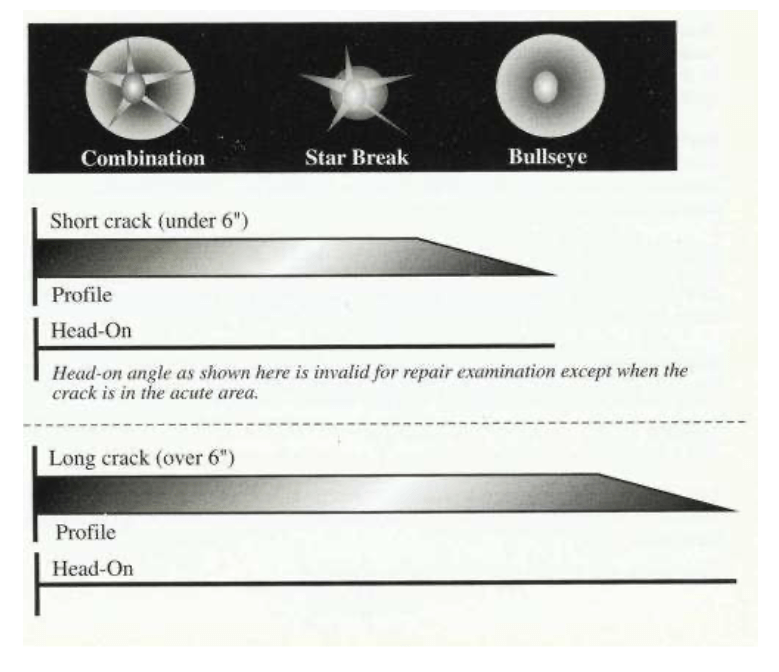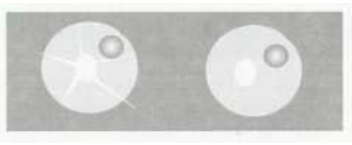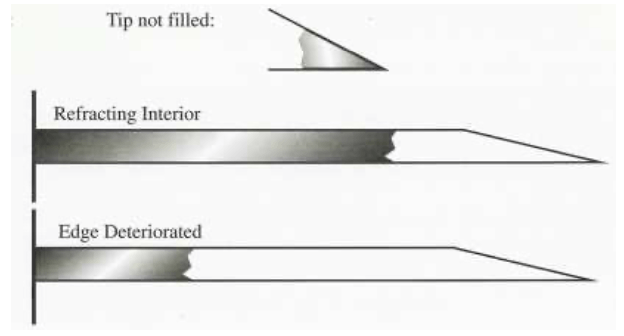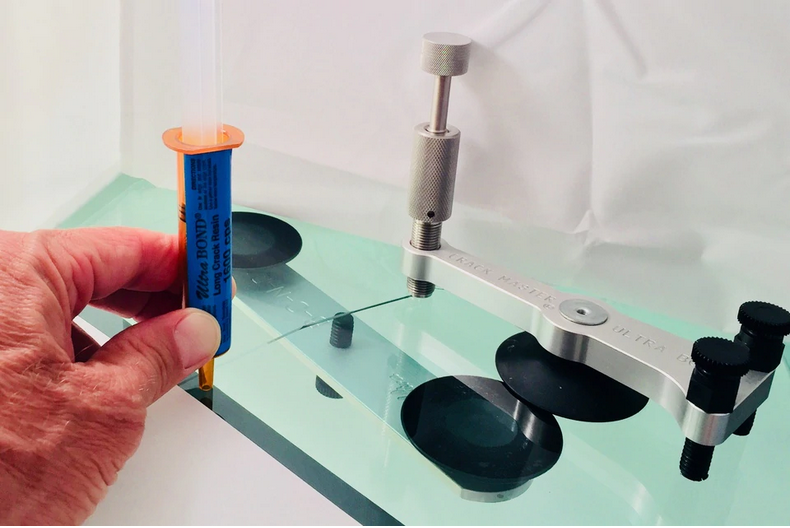Acute area:
An approximately 8-1/2" wide by 11' high area starting at the top of the steering wheel
encompassing the area which is directly in front of the driver. (see diagram)
Bottom of crack:
The very fine visible hairline running along the lamination.
Bullseye of stone break:
The dark circle encompassed by and surrounding the impact point.
Typically any small radiating clucks will converge into the bullseye. This is an open air space. The darkness is caused by light refraction in this open area.
Cosmetic blemish:
Small voids or air bubbles in the interior of any repair which appears as light refraction or dark spots. This specifically excludes the impact point.
Crack:
A single line of separation in the outer layer of glass, with a microscopic gap, widest at the edge and narrowest at the point.
Delamination:
Lamination deterioration usually exhibiting a foggy, whitish or yellowish appearance.
Deterioration:
A tensile or adhesion failure of the resin which appears as an area not repaired or exhibiting
refraction.
Edge of crack:
Where the crack meets one of the four sides of the windshield. This is the widest, most stressful part of the crack. If not properly repaired, deterioration may begin at this area.
Extending crack:
A leg of a stonebreak extending past the outer circumference of the bullseye, less than 3" in length.
Head-on angle:
The view of the crack which is perpendicular to the profile of the crack. The head-on angle is a ''seam'' and is always visible at the conclusion of a repair. This angle is not used by the technicians when repairing damage and is not a valid angle from which to determine the quality of a repair for inspection purposes.
Horizontal crack:
A short or long crack which commonly runs to the edge of the left or right side of the windshield. Also included would be unsurfaced cracks. A repair of this type may be acceptable across the acute area, provided that it does not contain any cosmetic blemishes as defined in these guidelines nor hinder the driver's vision.
Impact point:
The actual location on the outside layer of glass which was struck, usually by a stone. Typically, a small piece of glass is missing. The impact point is the location for the chemical's passage into the break. It is the size of this area of missing, or pulverized glass that generally determines the visibility of the resulting repair.
Interior of crack:
The largest area of the crack in between the top and bottom which is filled with the repair chemical. In a proper repair, this area should be clear, when viewed from the profile.
L-shaped crack:
A short or long crack which typically comes off an edge and changes direction after a few inches.
Leg:
Reference to a single crack usually less than 3" in length which emanates from the initial bullseye of the stone break. Star breaks are so called because of the multiple legs emanating from the center.
Long crack:
A crack over 6" in length and usually surfaced. Guidelines page 4
Point of crack:
The opposite of the edge, the tightest part of the crack terminating within the body of the windshield.
Profile of crack:
The angle which allows view of the entire thickness of the crack, from the outer surface of the glass to the lamination. The profile of the crack appears as light refraction and is the angle a technician observes when performing a repair. This is also the angle from which the repair MUST be inspected to accurately evaluate the quality of the repair.
Refraction:
The bending of light rays in passing from one medium to another; the mirroring (shiny) image seen along the profile of a crack. Refraction should have been significantly reduced when the completed repair is viewed from its profile.
Short crack:
A crack under 6" in length.
Tip of crack:
The ends of the cracks radiating from a stone break.
Stone break:
A sub-surfaced break on the outer layer of windshield glass, typically coin size and containing small radiating or extending cracks. Stone breaks are commonly referred to as star breaks, bullseyes, or combination breaks.
Top of crack:
The very fine visible hairline at or near the outside surface of the glass.
Vertical crack:
A short or long crack which runs up and down, typically off the top or bottom of the
windshield. Repair of vertical cracks which traverse the acute area are not recommended.












